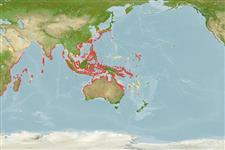分類 / Names
俗名 | 同種異名 | Catalog of Fishes(屬, 種) | ITIS | CoL | WoRMS | Cloffa
Teleostei >
Blenniiformes (Blennies)
鱸形目 (Blennies) >
Blenniidae (Combtooth blennies)
鳚科 (Combtooth blennies) > Blenniinae
Etymology: Petroscirtes: Latin, petra, -ae = stone + Greek, skirteo = to jump.
More on author: Valenciennes.
Environment: milieu / climate zone / depth range / distribution range
生態學
海洋; 半鹹淡水 礁區魚類; 深度上下限 1 - 15 m, usually ? - 10 m (Ref. 48636). 熱帶; 22°C - 28°C; 30°N - 30°S
Indo-West Pacific: East Africa to Papua New Guinea, north to southern Japan, south to New Caledonia.
印度-西太平洋: 東非到巴布亞新幾內亞, 北至日本南部, 南至新加勒多尼亞; 密克羅尼西亞的帛琉與雅普島。
大小 / 重量 / 年齡
Maturity: Lm ? range ? - ? cm
Max length : 11.0 cm SL 雄魚/尚未辨別雌雄; (Ref. 1602)
背棘 (總數) : 10 - 11; 背的軟條 (總數) : 17 - 21; 臀棘: 2; 臀鰭軟條: 17 - 21. Dark, broad stripe from snout through eye to caudal fin; stripe may be broken into segments (Ref. 4404). Highly variable in color and mimics Meiacanthus species (Ref. 48636).
深色又寬的斑紋從吻尖經過眼睛到尾鰭; 斑紋可能是夾雜著片段。 (參考文獻 4404) 高變異的顏色並且擬態 Meiacanthus 種。 (參考文獻 48636)
Adults inhabit coastal reefs and estuaries to depths of about 10 m (Ref. 48636). May also be found up to 15 m depth in coastal and lagoon reefs in sandy and weedy areas among clumps of Sargassum or other seaweeds. They also take shelter and nests inside small-necked bottles and abandoned worm tubes or shells (Ref. 90102). They feed on small crustaceans, diatoms, and perhaps other plant material associated with such clumps. They use their fangs defensively and will not hesitate to bite if handled, thus, species of this genus are avoided by predators (Ref. 205). Oviparous. Males uses shells but also ring-top cans for nesting (Ref. 48636). Eggs are demersal and adhesive (Ref. 205), and are attached to the substrate via a filamentous, adhesive pad or pedestal (Ref. 94114). Larvae are planktonic, often found in shallow, coastal waters (Ref. 94114). Mimic of Meiacanthus grammistes, which like all species of that genus possesses a pair of large grooved fangs in the lower jaw with associated venom glands. These bites are used defensively and Papuan variety is also a possible mimic of Meiacanthus vittatus (Ref. 90102).
發現於岸礁與河口到深度大約 10 公尺了。 (參考文獻 48636) 出現在在 馬尾藻 或者其他的海草的叢之中的沙地, 吃伴隨著此類海藻叢的小型甲殼動物,矽藻與也許其他的植物。 如果觸摸,他們防禦地使用他們的尖牙而且將不猶豫咬。 Meiacanthus grammistes 擬態, 類似那一個屬的所有種持有一對在下顎的毒液腺且有溝槽的大牙。 這些咬是作為防禦使用,而且如此那一個屬的種可以避開掠食者。 卵生的.(參考文獻 205) 雄性使用貝殼,也頂端環形的罐子築巢。 (參考文獻 48636)
Life cycle and mating behavior
成熟度 | 繁殖 | 產卵場 | 卵 | 孕卵數 | 仔魚
Oviparous, distinct pairing (Ref. 205).印度-西太平洋: 東非到巴布亞新幾內亞, 北至日本南部, 南至新加勒多尼亞; 密克羅尼西亞的帛琉與雅普島。
Myers, R.F., 1991. Micronesian reef fishes. Second Ed. Coral Graphics, Barrigada, Guam. 298 p. (Ref. 1602)
IUCN 瀕危狀態 (Ref. 130435: Version 2024-2)
無危 (LC) ; Date assessed: 25 March 2009
人類使用
漁業: 商業性; 水族館: 商業性
工具
特別的報告
下載 XML
網路資源
Estimates based on models
Preferred temperature (Ref.
123201): 25 - 29.3, mean 28.5 °C (based on 2854 cells).
Phylogenetic diversity index (Ref.
82804): PD
50 = 0.5005 [Uniqueness, from 0.5 = low to 2.0 = high].
Bayesian length-weight: a=0.00575 (0.00253 - 0.01308), b=3.06 (2.86 - 3.26), in cm total length, based on LWR estimates for this (Sub)family-body shape (Ref.
93245).
營養階層 (Ref.
69278): 2.1 ±0.2 se; based on diet studies.
回復力 (Ref.
120179): 高度, 族群倍增時間少於 15個月 (Preliminary K or Fecundity.).
Fishing Vulnerability (Ref.
59153): Low vulnerability (10 of 100).
Nutrients (Ref.
124155): Calcium = 141 [64, 242] mg/100g; Iron = 0.758 [0.421, 1.364] mg/100g; Protein = 18.1 [16.9, 19.3] %; Omega3 = 0.0887 [, ] g/100g; Selenium = 21.8 [9.6, 51.3] μg/100g; VitaminA = 114 [30, 410] μg/100g; Zinc = 2.87 [1.87, 4.40] mg/100g (wet weight);
